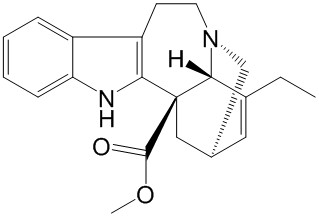Home
Products
Catharanthine



| Product Name | Catharanthine |
| Price: | $43 / 20mg |
| Catalog No.: | CN02155 |
| CAS No.: | 2468-21-5 |
| Molecular Formula: | C21H24N2O2 |
| Molecular Weight: | 336.43 g/mol |
| Purity: | >=98% |
| Type of Compound: | Alkaloids |
| Physical Desc.: | White powder |
| Source: | The herbs of Catharanthus roseus (L.) G.Don |
| Solvent: | Chloroform, Dichloromethane, Ethyl Acetate, DMSO, Acetone, etc. |
| SMILES: | CCC1=C[C@@H]2CN3[C@H]1[C@@](C2)(C(=O)OC)c1[nH]c2c(c1CC3)cccc2 |
| Contact us | |
|---|---|
| First Name: | |
| Last Name: | |
| E-mail: | |
| Question: | |
| Description | Catharanthine inhibits nicotinic receptor mediated diaphragm contractions with IC50 of 59.6 μM.Target: nAChRCatharanthine evokes a concentration-dependent attenuation of carbachol responses in the rat ileum preparation, producing rightward curve displacements and decreases in maximal agonist responses. The mixture of serpentine, plus ajmalicine and catharanthine reveals a concentration-dependent inhibitory effect of acethylcholinesterase (AchE), with an IC50 at ca. 2.25 μg/Ml [1]. Catharanthine can induce the self-association of tubulin into linear indefinite polymers with an efficacy that is 75% that of vinblastine or vincristine. Catharanthine binds to tubulin alpha-beta dimer with binding constant of 2.8 mM [2]. Catharanthine stimulates release of amylase from pancreatic fragments and to cause extensive degranulation of pancreatic acinar cells with accumulation of membrane material in the Golgi region. Catharanthine induces a delayed release of Ca2+ from prelabeled pancreatic fragments as compared to bethanechol [3]. Catharanthine inhibits epibatidine-induced Ca(2+) influx in TE671-α, -β, -γ, -δ cells in a noncompetitive manner with similar potencies IC50 of 17 mM-25 mM. Catharanthine inhibits [3H]TCP binding to the desensitized Torpedo AChR with higher affinity compared to the resting AChR. Catharanthine enhances [3H]cytisine binding to resting but activatable Torpedo AChRs, suggesting desensitizing properties [4]. |
| Density | 1.3±0.1 g/cm3 |
| Boiling Point | 491.5±45.0 °C at 760 mmHg |
| Flash Point | 251.1±28.7 °C |
| Exact Mass | 336.183777 |
| PSA | 45.33000 |
| LogP | 4.05 |
| Vapour Pressure | 0.0±1.2 mmHg at 25°C |